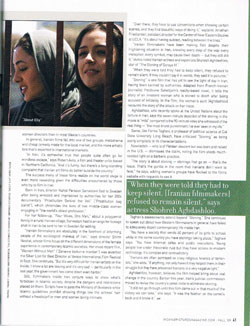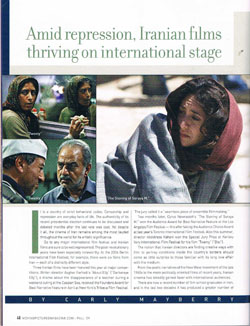From: Moving Pictures Magazine, Fall 2009
By Carly Mayberry
It is a country of strict behavioral codes. Censorship and repression are everyday facts of life. The authenticity of its recent presidential election continues to be discussed and debated months after the last vote was cast. Yet despite it all, the cinema of Iran remains among the most lauded throughout the world for its artistic significance.
Go to any major international film festival and Iranian films are sure to be well represented. The post-revolutionary years have been especially noteworthy. At the 2006 Berlin Film Festival, for example, there were six films from Iran – each of a distinctly different style.
Three Iranian films have been honored this year at major competitions. Writer-director Asghar Farhadi’s “About Elly,” a drama about the disappearance of a teacher during a weekend outing at the Caspian Sea, received the Founders Award for Best Narrative Feature in April at New York’s Tribeca Film Festival. The jury called it a “seamless piece of ensemble filmmaking.”
Two months later, Cyrus Nowrasteh’s “The Stoning of Soraya M.” won the Audience Award for Best Narrative Feature at the Los Angeles Film Festival – this after taking the Audience Choice Award at last year’s Toronto International Film Festival.
And also this summer, director Abdolreza Kahani was given the Special Jury Prize at Karlovy Vary for his film “Twenty.”
The notion that Iranian directors are finding creative ways with film to portray conditions inside the country’s borders should come as little surprise to those familiar with its long love affair with the medium.
From the poetic narratives of the New Wave movement of the late 1960s to the more politically oriented films of recent years, Iranian cinema has steadily gained favor with international audiences.
There are now a record number of film school graduates in Iran and in the last two decades it has produced a greater number of women directors than in most Western countries.
In general, Iranian films fall into one of two groups: melodramas and cheap comedies made for the local market and the more artistic fare that’s exported to international audiences.
“In Iran, it’s somewhat true that people quite often go for mindless escape,” says Robert Avila, a film and theater critic based in Northern California. “And it’s funny but there’s a long-standing complaint that Iranian art films do better outside the country.”
The success many of these films realize on the world stage is even more remarkable given the difficulties encountered by those who try to film there.
Born in Iran, director Nahid Persson fled to Switzerland more than 25 years ago after being arrested and imprisoned by authorities for her documentary, “Prostitution Behind the Veil,” which chronicles the lives of two middle-class women engaging in “the world’s oldest profession.”
For her most-recent effort, the Iran Film Festival entry “Four Wives, One Man” – about a polygamist family in a rural Iranian village – Persson had to arrange for footage shot in Iran to be sent to her in Sweden for editing.
“Iranian filmmakers are absolutely in the forefront of informing people of the sociological makeup of Iran,” says director Shirin Neshat, whose own films focus on the different dimensions of the female experience in contemporary Islamic societies. “But it’s very difficult for Iranian artists on the inside. I know a lot are leaving and it’s very sad – particularly in the last year, the government has come down even harder.”

Still, filmmakers inside Iran conjure ways to show what’s forbidden in Islamic society, despite the dangers and restrictions placed on them. Scripts have to pass the Ministry of Guidance while Islamic guidelines prohibit showing things like the actress’ hair without a headscarf or men and women being intimate.
“Over there they have to use conventions when showing certain scenes and they find beautiful ways of doing it,” explains Jonathan Friedlander, assistant director for the Center of Near Eastern Studies at UCLA. “It’s about having subtext, reading between the lines.”
“Iranian filmmakers have been making film despite their frightening situation in Iran, knowing every step of the way every metaphor, every symbol, may cause their death – but they still did it,” adds noted Iranian actress and expatriate Shohreh Aghdashloo, star of “The Stoning of Soraya M.” “When they’re told they had to keep silent, they refused to remain silent. If they couldn’t say it in words, they said it in pictures.”
“Stoning” is one film that has yet to see the light of day in Iran, having been banned by authorities. Adapted from French-Iranian journalist Freidoune Sahebjam’s reality-based novel, it tells the story of an innocent woman who is stoned to death after being accused of infidelity. In the film, the woman’s aunt (Aghdashloo) recounts the story of the attack on her niece.
Aghdashloo, who recently spoke at the United Nations about the torture in Iran, says the seven-minute depiction of the stoning in the movie is “mild” compared to the 90-minute video of the real thing she has witnessed – “the most brutal punishment I’ve ever seen in my life,” she says.
Some like Fariba Taghavi, a professor of political science at Cal State University Long Beach, have criticized “Stoning” as being overly simplistic in its characterizations.
Nowrasteh – who is of Persian descent but was born and raised in the U.S. – dismisses the claim, noting the film sheds much-needed light on a barbaric practice.
“The story is about stoning – stonings that go on – that’s the issue. That’s the gorilla in the room that Iranians don’t want to face,” he says, adding women’s groups have flocked to the film’s website with requests to see it.
Taghavi’s assessments extend beyond “Stoning.” She continues to speak out about how Western filmmakers in general have failed to adequately depict contemporary life inside Iran.
“You have a society that sends 60 percent of its girls to school while in the same country you have stonings taking place,” Taghavi says. “You have Internet cafes and public executions. Young people live under theocratic rule but they have access to modern technology. It’s complex and contradictory.
“Iranians are often portrayed as crazy religious fanatics or terrorists,” she adds. “If anything, not only haven’t they helped them in their struggle but they have presented Iranians in a very negative light.”
Aghdashloo, however, believes “Stoning” helped bring about real change in the country. Earlier this year, Iran’s judicial commission moved to revise the country’s penal code to eliminate stoning.
“It did not go through until this film came out – that much of the victory we can take,” she says. It was the feather on the camel’s back and it broke it.”

